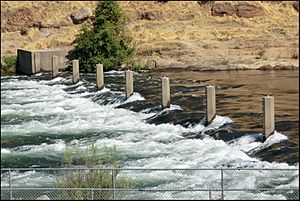Nimbus Dam facts for kids
Quick facts for kids Nimbus Dam |
|
|---|---|
 |
|
| Country | United States |
| Location | Sacramento County, California |
| Coordinates | 38°38′10″N 121°13′11″W / 38.636095°N 121.219806°W,inline |
| Status | Operational |
| Construction began | 1952 |
| Opening date | 1955 |
| Owner(s) | Bureau of Reclamation |
| Dam and spillways | |
| Impounds | American River |
| Height | 87 ft (27 m) |
| Length | 1,093 ft (333 m) |
| Elevation at crest | 132 ft (40 m) |
| Width (crest) | 28 ft (8.5 m) |
| Width (base) | 135 ft (41 m) |
| Dam volume | 8,760 acre-feet (10,810 dam3) |
| Reservoir | |
| Creates | Lake Natoma |
| Catchment area | 1,898 sq mi (4,920 km2) |
| Power station | |
| Installed capacity | 13.5 MW |
| Annual generation | 51,097,000 KWh |
The Nimbus Dam is a hydroelectric dam on the American River in Folsom, California. It helps create Lake Natoma, a reservoir that holds about 8,700 acre-feet of water. The dam is 87 feet tall and stretches 1,093 feet across the river.
Nimbus Dam has two generators that make electricity. Each one can power over 200,000 100-watt light bulbs! The dam also has 18 special gates called radial gates. These gates help control the water flow. Most of these gates still have their original protective coating from when the dam was built in 1955.
This dam is part of a big water project called the Central Valley Project (CVP). This project helps provide water for farms and cities across California's Central Valley. Nimbus Dam was built to help control water from the Folsom Dam upstream. It also directs water into the Folsom South Canal. Construction started in 1952, and the dam opened in 1955.
Contents
How the Nimbus Powerplant Works
The Nimbus Powerplant is on the north side of the American River, next to the dam. It acts as a backup power source for the main powerplant at Folsom Dam.
- Power Generation: Each of the two generators at Nimbus Powerplant creates about 7,700 kilowatts of electricity.
- Turbines and Water Flow: Two powerful turbines, each with 9,400 horsepower, spin the generators. Water flows through six large pipes, called penstocks, to turn these turbines.
- Power Distribution: The electricity made here, along with power from Folsom Dam, is sold by the Western Area Power Administration.
The dam also helps send water into the Folsom South Canal. This canal carries water to areas near Lodi, California. It provides water for farming, drinking, and industrial uses.
Keeping Nimbus Dam Strong: The Radial Gates Project
The United States Bureau of Reclamation started a big project in 2015 to fix the Nimbus Dam's radial gates. These gates are very important for controlling water.
- Why the Project is Needed: Most of the gates still have their original coating from the 1950s. This coating protects them from rust and wear. Over time, it wears out, so the gates need new protection.
- What the Project Does: The project involves replacing the coating on 14 of the gates. It also includes building a new storage building. This work helps keep the dam safe and working well.
- Protecting the Environment: When working on the dam, managers must follow many environmental rules. These rules help protect fish, wildlife, and clean air and water. This ensures the project doesn't harm the environment.
Nimbus Dam's Impact on Fish and Wildlife
Nimbus Dam has changed the American River for fish, especially salmon.
- Lake Natoma and Fish: The water in Lake Natoma is often too cold for many types of fish to grow naturally. The fast flow of water from Nimbus Dam also makes it hard for tiny organisms, which fish eat, to thrive.
- Trout Stocking: To help, the Department of Fish and Game puts 20,000 to 30,000 trout into Lake Natoma each year. This allows people to still enjoy fishing there.
- Salmon Habitat Loss: Before the dam, salmon could travel far up the American River to lay their eggs. The dam blocked their path, greatly reducing their natural habitat.
- Nimbus Fish Hatchery: To help salmon, the Nimbus Fish Hatchery was built in 1958, just downstream from the dam. This hatchery provides a safe place for salmon to lay eggs. Young salmon are then released back into the river.
- Fishing Changes: Fishing was popular below the dam. However, to protect the salmon's spawning areas, the Nimbus Basin was closed to all fishing in 2018. This closure helps with a project to improve how salmon are collected for the hatchery.
Water Flow and Quality in the American River
The amount of water flowing in the American River changes a lot throughout the year.
- Seasonal Water Flow: Almost half of the rain and snow in the Sacramento area falls in just two winter months. In summer, there's very little rain. A lot of the river's water comes from melting snow in the Sierra Nevada Mountains.
- Dam's Role: Because of these natural changes, Nimbus Dam adjusts how much water it releases. This helps manage the river's flow all year.
- Protecting Water Quality: In 1993, the County of Sacramento started the Water Forum. This group works with other counties to make sure the region has clean, reliable water by 2030. They also work to protect the fish and wildlife in the Lower American River.



